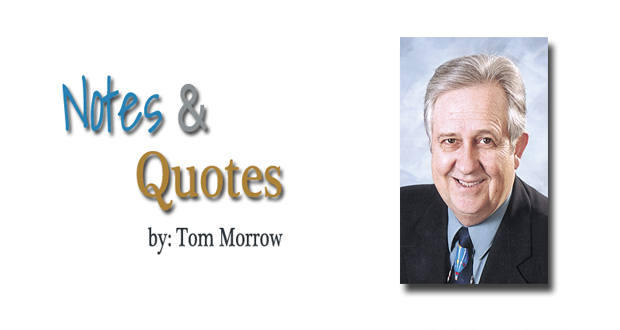The Sacrifices of ‘The Greatest Generation’
By Tom Morrow
In this age of plenty, only those of us who have reached our seventh, eighth or ninth decade can recall when America’s civilian population “went to war.”
Our civilian parents and grandparents who survived World War II are referred to as members of “The Greatest Generation.” Here’s one reason: “rationing.”
World War II started on Sept. 1, 1939, when Great Britain and France declared war on Nazi Germany. By the summer of 1941, the British were appealing to Americans to conserve food and send supplies to them.
The U.S. Office of Price Administration (OPA) warned Americans of pending rationing of gasoline, steel, aluminum, and electricity shortages. Factories began converting to military production and a rationing system became a reality soon after the Dec. 7, 1941, Japanese attack on Pearl Harbor.
Within a week after the attack, 7,500 unpaid, volunteer ration boards across the nation were formed. Tires were first to be rationed. Each family received an allotment of tires. A shortage of natural rubber ensued since the Japanese had conquered the rubber-producing regions of Southeast Asia. Although synthetic rubber had been invented, productions hadn’t been able to compete with natural rubber products. There wasn’t enough manufacturing capacity to manufacture synthetic rubber.
My Dad was an ammunition worker in a Des Moines, Iowa factory. In 1943, he transferred to a war production plant in Lincoln, Neb., but to get there he had to borrow four near-new tires from a friend to make the 125-mile journey. Once in Lincoln, he removed the good tires from our 1936 Chevy, put back on his well-worn tires, shipping the borrowed tires back to Des Moines.
By Jan. 1, 1942, the War Production Board was formed and ordered the temporary end of all civilian automobile production and sales, leaving dealers with one half million unsold cars.
By early February 1942, automobile factories re-tooled to produce tanks, aircraft, weapons, and a new product: the Jeep – what General Eisenhour called “one of the three decision weapons of the War.
Ration books were issued through more than 100,000 schoolteachers, PTA groups, and other volunteers. A national speed limit of 35 miles per hour was imposed to save fuel and tires. Later that month volunteers began distributing gasoline cards by classification. To get qualified gas rationing stamps, civilians had to appear before a local rationing board.
Windshield stickers were issued via qualification. An “A” sticker was the lowest priority for gasoline rationing. It entitled the car owner to 3 gallons of gasoline per week. “B” stickers were issued to workers in the military industry for 8 gallons per week. “C” stickers were for those civilians deemed “very essential” to the war effort, such as doctors. “T” rations were made available for truckers and “X” stickers entitled the holder to unlimited gasoline supplies for those deemed to be of the highest priority such as clergy, police, firemen, and civil defense workers. A big scandal erupted when 200 U.S. Congressmen received “X “stickers.
In some regions violating gas rationing was so prevalent night courts were set up to take care of the number of violators caught.
Each person in a household received a ration book, including babies and small children who qualified for canned milk not available to others. Sugar was the first commodity rationed at a half-a-pound per person per week. Coffee was rationed to 1 pound every five weeks because of German U-boat attacks on shipping in the Atlantic from Brazil.
By the end of 1942, rationing was placed on other items: typewriters, bicycles, silk, nylon, fuel oil, stoves, meat, lard, shortening and food oils, cheese, butter, margarine, processed foods (canned, bottled, and frozen), dried fruits, canned milk, firewood, coal, jams, jellies, and fruit butter. Metal became precious. By April 1942, to purchase a tube of toothpaste, you had to turn in the used-up tube.
Penicillin was rationed to the military. Hospitals received only small amounts because it was not mass-produced for civilian use until after the War.
Ration books were issued with a supply of stamps. Four stamps were required to buy 5 pounds of sugar; 30 for a pair of shoes. As expected, black market racketeering emerged among otherwise honest citizens. Some found themselves before a judge for counterfeiting stamps. The OPA ordered stores not to accept stamps they did not personally clip from the books because not everyone played by the rules.
When the war ended in August 1945, gas rationing was lifted as was most other rationing restrictions except for sugar, which lasted until 1947. Great Britain had rationing on some levels until 1953. A favorite commodity in England: American-made Spam.
Can you imagine today’s society making the above drastic sacrifices? I think not.



